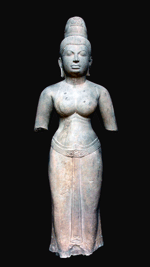COLLECTION
STONE OBJECTS
———————————————
DEVI
 Material:
Sandstone Material:
Sandstone
Dimensions: H: 127 cm
Date: First half of VIIth century
Provenance: Koh Krieng, Sambor (Mekong) (Kratie)
Collection: National Museum of Cambodia,
Phnom Penh
B.45 B.71.1 Ka.1621
According to Professor Jean Boisselier, this female statue is
dated to the middle of the 7th century in the Sambor Prei Kuk
style. One of the powerful kings of Chenla, Isanavarman, erected
the city called Isanapura at Sambor Prei Kuk currently in Kompong
Thom province. There we can still find many brick temples. Because
of the absence of attributes, no one can claim this is either
Visnu’s spouse or Siva’s spouse. The ancient Khmer
used to pay respect to both the main gods and their spouses. “The
morphology is remarkably close to the characteristics of Cambodian
women today, so that one is tempted to see in this Devi an inspired
personification of Khmer womanhood.”
Traditionally, Khmer women wear a long skirt or
‘sampot’. This sampot has a large knot tucked in front
and a long central pleat that falls to the ankles. The lower pleated
edge is splayed. The belt is made up of five cords and has a large
clasp with very fine ornamentation. The style of goddess’s
coiffure (jata) is named by a Cambodian expression ‘bokor’
(hump of a bull). This jata is divided into two parts and decorated
at the rear with five stands of falling hair.
The large pelvis, round closely-set breasts, folds of the abdomen
and neck, round cheeks, full undulating lips, narrow nose, long
earlobes and high jata of tresses make up the exceptional beauty
of this female divinity.
| 

